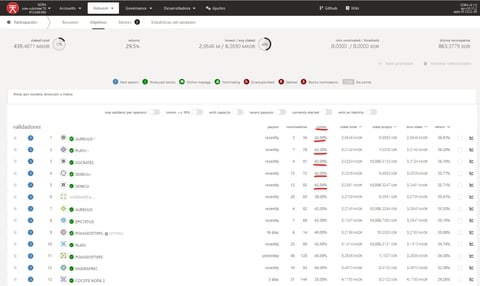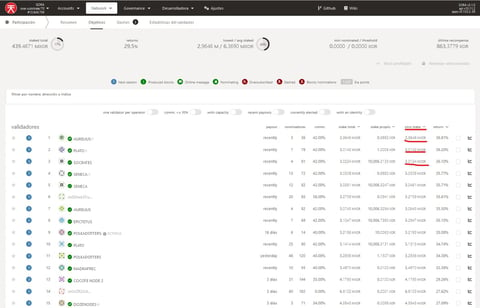How to Choose a Nominator?
How do I correctly choose a nominator to maximize my earnings on the Sora network?
12/22/20233 min read


How to properly choose a nominator to maximize my earnings?
As we have discussed in this other article, it is important to know how to choose a set of committed and quality validators. Once we have a clear understanding of the basic concepts (important to read the previous article), we can optimize our rewards with very simple guidelines. We know that the amount of rewards to be distributed among the 69 validators in Val will always be conditioned by the volume of transactions on the Sora network, with more transactions yielding higher rewards and fewer transactions yielding lesser rewards.
Despite this variable, we can optimize the rewards we receive in each ERA (6 hours), mainly taking into account these 2 factors:
1.- Validator Commissions: This is the percentage that the validator takes as their reward. The commissions are deducted from the total rewards generated in that ERA. Therefore, the higher the commission percentage, the lower the proportion of rewards distributed to the nominators, which reduces the APY for them.
2.- Total Stake of Nominators (other stake): The total amount of XOR staked by all nominators in each validator determines the base upon which the rewards are distributed (minus the validator's commissions). A nominator will receive a portion of the rewards proportional to their share in the total stake of the nominators.
In this context, nominators should consider both the validator's commission rate and their own stake relative to the total stake of all nominators when evaluating their potential APY.
Let's consider several examples with a nominator named Bob:
Example 1: Impact of Validator Commission Percentage.
Assuming nominator “Bob” stakes 1,000 XOR.
Validator A: 10% Commission, Total Stake: 10,000 XOR
Validator B: 30% Commission, Total Stake: 10,000 XOR
Validator C: 50% Commission, Total Stake: 10,000 XOR
Rewards received by the validator according to the tx volume in one ERA: 10 Val; after deducting the validator's own commission:
Validator A: 9 VAL for nominators
Validator B: 7 VAL for nominators
Validator C: 5 VAL for nominators
Nominator “Bob's” ratio (1,000 XOR staked):
Validator A: 10% of 9 VAL = 0.9 VAL
Validator B: 10% of 7 VAL = 0.7 VAL
Validator C: 10% of 5 VAL = 0.5 VAL
Example 2: Impact of Total Stake by Nominators (other stake), relative to Nominator “Bob’s” Stake.
Assuming “Bob” stakes 1,000 XOR.
Validator A: 20% Commission, Total Stake: 50,000 XOR
Validator B: 20% Commission, Total Stake: 100,000 XOR
Validator C: 20% Commission, Total Stake: 200,000 XOR
Rewards received by the validator according to the tx volume in one ERA: 10 Val; after deducting the validator's own commission.
Validator A: 2% of 8 VAL = 0.16 VAL
1000/50000*100= 2%
Validator B: 1% of 8 VAL = 0.08 VAL
1000/100000*100= 1%
Validator C: 0.5% of 8 VAL = 0.04 VAL
1000/200000*100= 0.5%
Example 3: Combination of both factors, Commission and Total Stake by nominators (other stake).
Assuming “Bob” stakes 1,000 XOR.
Validator A: 15% Commission, Total Stake: 100,000 XOR
Validator B: 25% Commission, Total Stake: 50,000 XOR
Validator C: 20% Commission, Total Stake: 75,000 XOR
Rewards received by the validator according to the tx volume of one ERA: 10 Val.
Validator A: 10 VAL - 15% = 8.5 VAL 1% of 8.5 VAL = 0.085 VAL
Validator B: 10 VAL- 25% = 7.5 VAL 2% of 7.5 VAL = 0.15 VAL
Validator C: 10 VAL - 20% = 8 VAL 1.33% of 8 VAL = 0.106 VAL
In these examples, the amount of XOR staked by the nominator “Bob” is constant (1,000 XOR), which makes it easier to compare how different factors (validator commission and total stake of the group of nominators “other stake”) affect the APY. These examples illustrate how a nominator can receive different amounts of VAL as rewards depending on the validator's commission structure and their proportional participation in the total stake of the group of nominators (other stake).




Contacts
rubrum90@protonmail.com
Socials
Subscribe to our newsletter
Aviso legal: Este blog es de naturaleza personal y tiene como único propósito proporcionar información y opiniones sobre el proyecto Sora, así como temas relacionados. Las opiniones expresadas en este blog son exclusivamente las del autor y no representan necesariamente las opiniones o posiciones de ninguna entidad, organización o individuo relacionado con Sora o cualquier otro proyecto mencionado. Cualquier información proporcionada en este blog se basa en la comprensión y conocimiento del autor en el momento de la publicación. Los lectores deben tener en cuenta que la información puede cambiar con el tiempo. Se recomienda verificar la información con fuentes adicionales y oficiales. Este blog no pretende proporcionar asesoramiento financiero, legal ni de inversión. Los lectores deben tomar sus propias decisiones informadas y buscar asesoramiento profesional cuando sea necesario.
